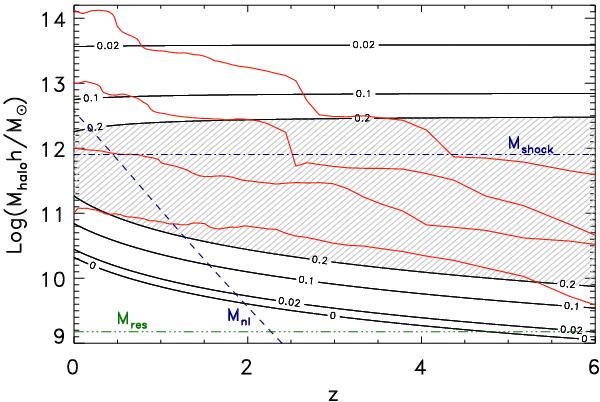Fig. 3

Growth of halo mass and efficiency of star formation. The contours show the efficiency of star formation,  , as a function of redshift and halo mass, for the set of parameters that fit best the galaxy mass function (Sect. 3.1 and Table 1). The horizontal dash-dotted line shows the critical halo mass for shock heating, Mhalo = Mshock. Baryons make stars efficiently only in the horizontal band of the diagram shown by the shaded region. The red irregular lines show the mass growth of four haloes, whose present masses are about 1011, 1012, 1013 and 1014 h-1 M⊙. They are backwards tracks for the most massive progenitors. The diagonal dashed line shows the characteristic mass scale Mnl on which density fluctuations become non-linear at redshift z, i.e. where σ(Mnl,z) = 1.68. The horizontal green line shows the mass resolution Mres = 1.5 × 109 h-1 M⊙ of the N-body simulation.
, as a function of redshift and halo mass, for the set of parameters that fit best the galaxy mass function (Sect. 3.1 and Table 1). The horizontal dash-dotted line shows the critical halo mass for shock heating, Mhalo = Mshock. Baryons make stars efficiently only in the horizontal band of the diagram shown by the shaded region. The red irregular lines show the mass growth of four haloes, whose present masses are about 1011, 1012, 1013 and 1014 h-1 M⊙. They are backwards tracks for the most massive progenitors. The diagonal dashed line shows the characteristic mass scale Mnl on which density fluctuations become non-linear at redshift z, i.e. where σ(Mnl,z) = 1.68. The horizontal green line shows the mass resolution Mres = 1.5 × 109 h-1 M⊙ of the N-body simulation.
Current usage metrics show cumulative count of Article Views (full-text article views including HTML views, PDF and ePub downloads, according to the available data) and Abstracts Views on Vision4Press platform.
Data correspond to usage on the plateform after 2015. The current usage metrics is available 48-96 hours after online publication and is updated daily on week days.
Initial download of the metrics may take a while.


